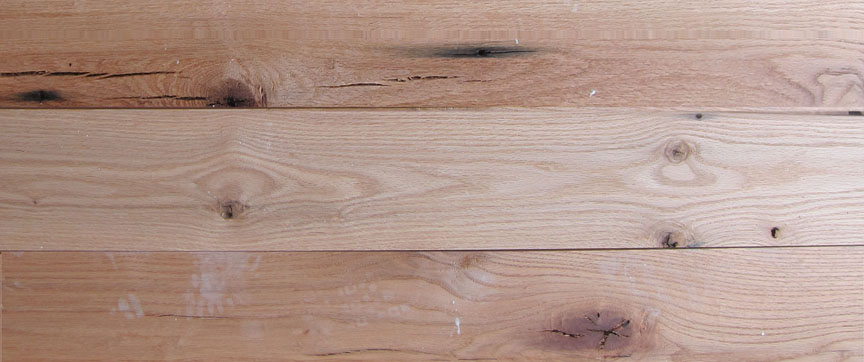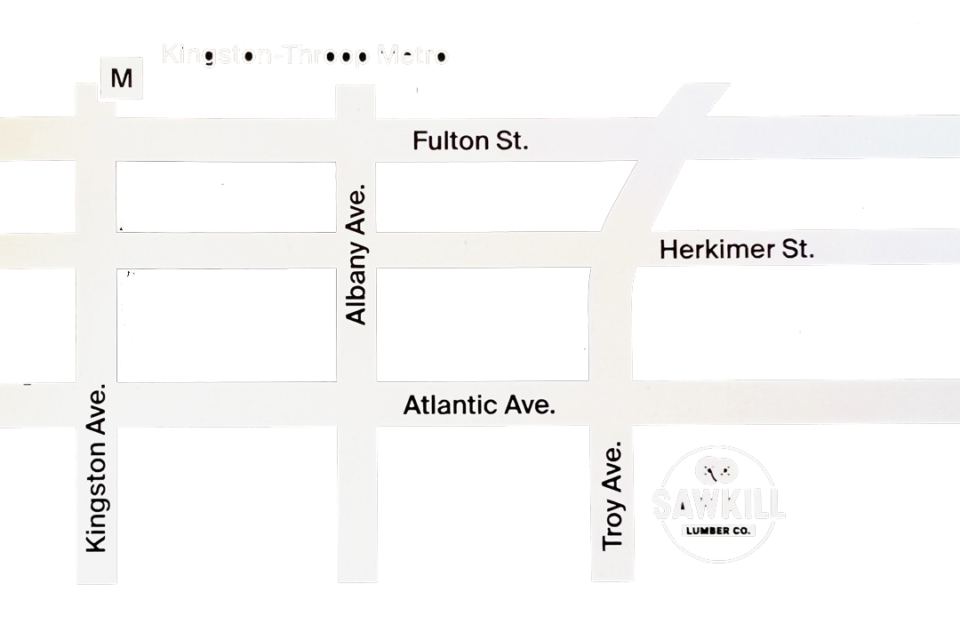 Reclaimed white oak has been the most popular reclaimed wood, at least here in the northeast, from about 2007-2010, and remains in high demand now. Before 2007, most specifications for reclaimed oak were simply reclaimed oak and differentiation between red and white oak, were far less common. Reclaimed white oak is fairly common in Ohio, Pennsylvania and parts of New York and New England. Traveling further south one begins to see more red oak than white oak and further north into Canada and northern New England one finds more softwoods, as well as beech and maple. Although one occasionally finds oak in industrial structures, the majority of reclaimed white oak and most other hardwoods for that matter, come from barns. Aesthetically, reclaimed white oak is a porous grained hardwood like ash and chestnut. Because of the significant amount of character ranging from patina, wormholes, nail staining, checking, fleck, saw marks and knots, it lends itself well to rustic applications where a sense of history and age is desired. Whereas most woods contain some amount of yellow and/or red, white oak has a very neutral color tone ranging from beige to brown that tends to darken with age. Preserving the dark patina on the surface is not always necessary as the checks and wormholes which tend to be somewhat common usually contain the dark contrasting tone range designers look for. As with most barn woods, white oak is commonly found in one of three forms: joists, beams and boards. Boards and joists are suited to be planed smooth or with the original surface left intact to preserve the original saw marks. Beam sawn stock is often more desirable from a woodworking standpoint as the boards are flat and square off the saw and can be sawn to any thickness whereas board and joist stock are usually just 1” or 2” thick, with 3” somewhat less common. Although beam stock tends to be more consistent in color, both beam stock and board stock contain a fair amount of contrast both from one board to another, as well as within each board. Because of the high demand for reclaimed white oak and the challenge associated with obtaining quality material, many suppliers have tried to market new material, either standing dead or just character grade white oak instead of offering legitimate old growth reclaimed white oak. Since white oak is a slow growing (and hence tight grained) wood, these newer alternatives offer a reasonable substitute at a fairly significant discount for those who do not need the real thing. However, when buying reclaimed white oak, be very clear in what you want and make sure that you are not paying for a clever marketing campaign or dealing with a shady supplier who may try to pass off new material for old. When specifying or ordering reclaimed white oak, things to consider – percentage/type of defects including rot, extent of bug damage, splits, pockets, pegholes. Hard to dry/dryness. Normal character voids, bug channels, dimensions, etc. Original surface vs resawn. Quality of material. Sunken white oak, European oak, Barrel stave, newly reclaimed white oak, character grade new oak, old growth reclaimed white oak (barn, house or factory).
Reclaimed white oak has been the most popular reclaimed wood, at least here in the northeast, from about 2007-2010, and remains in high demand now. Before 2007, most specifications for reclaimed oak were simply reclaimed oak and differentiation between red and white oak, were far less common. Reclaimed white oak is fairly common in Ohio, Pennsylvania and parts of New York and New England. Traveling further south one begins to see more red oak than white oak and further north into Canada and northern New England one finds more softwoods, as well as beech and maple. Although one occasionally finds oak in industrial structures, the majority of reclaimed white oak and most other hardwoods for that matter, come from barns. Aesthetically, reclaimed white oak is a porous grained hardwood like ash and chestnut. Because of the significant amount of character ranging from patina, wormholes, nail staining, checking, fleck, saw marks and knots, it lends itself well to rustic applications where a sense of history and age is desired. Whereas most woods contain some amount of yellow and/or red, white oak has a very neutral color tone ranging from beige to brown that tends to darken with age. Preserving the dark patina on the surface is not always necessary as the checks and wormholes which tend to be somewhat common usually contain the dark contrasting tone range designers look for. As with most barn woods, white oak is commonly found in one of three forms: joists, beams and boards. Boards and joists are suited to be planed smooth or with the original surface left intact to preserve the original saw marks. Beam sawn stock is often more desirable from a woodworking standpoint as the boards are flat and square off the saw and can be sawn to any thickness whereas board and joist stock are usually just 1” or 2” thick, with 3” somewhat less common. Although beam stock tends to be more consistent in color, both beam stock and board stock contain a fair amount of contrast both from one board to another, as well as within each board. Because of the high demand for reclaimed white oak and the challenge associated with obtaining quality material, many suppliers have tried to market new material, either standing dead or just character grade white oak instead of offering legitimate old growth reclaimed white oak. Since white oak is a slow growing (and hence tight grained) wood, these newer alternatives offer a reasonable substitute at a fairly significant discount for those who do not need the real thing. However, when buying reclaimed white oak, be very clear in what you want and make sure that you are not paying for a clever marketing campaign or dealing with a shady supplier who may try to pass off new material for old. When specifying or ordering reclaimed white oak, things to consider – percentage/type of defects including rot, extent of bug damage, splits, pockets, pegholes. Hard to dry/dryness. Normal character voids, bug channels, dimensions, etc. Original surface vs resawn. Quality of material. Sunken white oak, European oak, Barrel stave, newly reclaimed white oak, character grade new oak, old growth reclaimed white oak (barn, house or factory).
Sizes: 3/4-4/4 thickness x 3-8″ widths x 3-12′ legnths
Applications: Flooring and paneling.
Defining Characteristic: 3/4-4/4 thickness x 3-9″ widths x 3-12′ lengths


